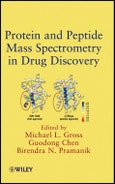An instrumental analytical method for quantifying the mass and characterization of various samples from small molecules to large proteins, mass spectrometry (MS) has become one of the most widely used techniques for studying proteins and peptides over the last decade. Bringing together the work of experts in academia and industry, Protein and Peptide Mass Spectrometry in Drug Discovery highlights current analytical approaches, industry practices, and modern strategies for the characterization of both peptides and proteins in drug discovery.
Illustrating the critical role MS technology plays in characterizing target proteins and protein products, the methods used, ion mobility, and the use of microwave radiation to speed proteolysis, the book also covers important emerging applications for neuroproteomics and antigenic peptides. Placing an emphasis on the pharmaceutical industry, the book stresses practice and applications, presenting real-world examples covering the most recent advances in mass spectrometry, and providing an invaluable resource for pharmaceutical scientists in industry and academia, analytical and bioanalytical chemists, and researchers in protein science and proteomics.
Table of Contents
PREFACE xvCONTRIBUTORS xvii
PART I METHODOLOGY 1
1 Ionization Methods in Protein Mass Spectrometry 3
Ismael Cotte-Rodriguez, Yun Zhang, Zhixin Miao, and Hao Chen
1.1 History of the Development of Protein Mass Spectrometry 4
1.2 Laser-Based Ionization Methods for Proteins 5
1.3 Spray-Based Ionization Methods for Proteins 13
1.4 Ambient Ionization Methods 20
1.5 Conclusions 30
Acknowledgments 30
References 30
2 Ion Activation and Mass Analysis in Protein Mass Spectrometry 43
Cheng Lin and Peter O’Connor
2.1 Introduction 43
2.2 Ion Activation and Tandem MS Analysis 46
2.3 Mass Analyzers 59
References 81
3 Target Proteins: Bottom-up and Top-down Proteomics 89
Michael Boyne and Ron Bose
3.1 Mass Spectral Approaches to Targeted Protein Identification 89
3.2 Bottom-up Proteomics 90
3.3 Top-down Approaches 96
3.4 Next-Generation Approaches 98
References 99
4 Quantitative Proteomics by Mass Spectrometry 101
Jacob Galan, Anton Iliuk, and W. Andy Tao
4.1 Introduction 101
4.2 In-Cell Labeling 105
4.3 Quantitation via Isotopic Labeling of Proteins 107
4.4 Quantitation via Isotopic Labeling on Peptides 112
4.5 Label-Free Quantitation 116
4.6 Conclusions 119
Acknowledgment 120
References 120
5 Comparative Proteomics by Direct Tissue Analysis Using Imaging Mass Spectrometry 129
Michelle L. Reyzer and Richard M. Caprioli
5.1 Introduction 129
5.2 Conventional Comparative Proteomics 130
5.3 Comparative Proteomics Using Imaging MS 131
5.4 Conclusions 136
Acknowledgments 137
References 137
6 Peptide and Protein Analysis Using Ion Mobility–Mass Spectrometry 139
Jeffrey R. Enders, Michal Kliman, Sevugarajan Sundarapandian, and John A. McLean
6.1 Ion Mobility–Mass Spectrometry: Instrumentation and Separation Selectivity 139
6.2 Characterizing and Interpreting Peptide and Protein Structures 147
6.3 Applications of IM-MS to Peptide and Protein Characterizations 152
6.4 Future Directions 158
Acknowledgments 159
References 160
7 Chemical Footprinting for Determining Protein Properties and Interactions 175
Sandra A. Kerfoot and Michael L. Gross
7.1 Introduction to Hydrogen–Deuterium Exchange 175
7.2 Experimental Procedures 178
7.3 Mass Spectrometry-Based HDX in Practice 182
7.4 Protein Footprinting via Free-Radical Oxidation 193
7.5 Chemical Crosslinking 198
7.6 Selective and Irreversible Chemical Modification 201
7.7 Conclusion 205
References 206
8 Microwave Technology to Accelerate Protein Analysis 213
Urooj A. Mirza, Birendra N. Pramanik, and Ajay K. Bose
8.1 Introduction 213
8.2 Microwave Technology 215
8.3 Summary 224
Acknowledgments 224
References 224
9 Bioinformatics and Database Searching 231
Surendra Dasari and David L. Tabb
9.1 Overview 231
9.2 Introduction to Tandem Mass Spectrometry 231
9.3 Overview of Peptide Identification with Database Searching 234
9.4 MyriMatch-IDPicker Protein Identification Pipeline 235
9.5 Results of a Shotgun Proteomics Study 246
9.6 Improvements to MyriMatch Database Search Engine 248
9.7 Applications of MyriMatch-IDPicker Pipeline 250
9.8 Conclusions 251
Acknowledgments 251
References 251
PART II Applications 253
10 Mass Spectrometry-Based Screening and Characterization of Protein–Ligand Complexes in Drug Discovery 255
Christine L. Andrews, Michael R. Ziebell, Elliott Nickbarg, and Xianshu Yang
10.1 Introduction 255
10.2 Affinity Selection Mass Spectrometry (AS-MS) 256
10.3 Solution-Based AS-MS as Screening Technologies 258
10.4 Gas-Phase Interactions 267
10.5 Enzyme Activity Assays Using MS for Screening or Confirming Drug Candidates 271
10.6 Conclusions and Future Directions 276
References 277
11 Utilization of Mass Spectrometry for the Structural Characterization of Biopharmaceutical Protein Products 287
Amareth Lim and Catherine A. Srebalus Barnes
11.1 Introduction 287
11.2 MS-Based Approach for the Characterization of Recombinant Therapeutic Proteins 288
11.3 Cell Culture Development 290
11.4 Purification Development 294
11.5 Formulation Development 300
11.6 Analytical Method Development 304
11.7 Confirmation of Structure/Product Comparability Assessment 311
11.8 Conclusions 313
Acknowledgments 315
References 315
12 Post-translationally Modified Proteins: Glycosylation, Phosphorylation, and Disulfide Bond Formation 321
Anthony Tsarbopoulos and Fotini N. Bazoti
12.1 Introduction 321
12.2 Glycosylation 322
12.3 Phosphorylation 338
12.4 Disulfide Bond Detection and Mapping 347
12.5 Future Perspectives 350
Acknowledgments 352
Abbreviations 353
References 354
13 Mass Spectrometry of Antigenic Peptides 371
Henry Rohrs
13.1 Introduction 371
13.2 Analysis of Antigenic Peptides 374
13.3 Examples of the Application of Mass Spectrometry to Antigenic Peptide Study 381
13.4 Future Work 385
Acknowledgments 386
Abbreviations 387
References 387
14 Neuropeptidomics 393
Jonathan V. Sweedler, Fang Xie, and Adriana Bora
14.1 Introduction 393
14.2 Neuropeptidomics: Characterizing Peptides in the Brain 394
14.3 Sample Preparation for Mass Spectrometry 395
14.4 Separations 405
14.5 Peptide Characterization via Mass Spectrometry 407
14.6 Conclusions 419
14.7 Future Perspectives 419
Acknowledgments 420
References 420
15 Mass Spectrometry for the Study of Peptide Drug Metabolism 435
Patrick J. Rudewicz
15.1 Introduction 435
15.2 Peptide Drug Metabolism 436
15.3 LC-MS/MS for Metabolite Identification 437
15.4 Quantitative Analysis 439
15.5 Case Study: IL-1b Protease Inhibitors 440
15.6 Future Directions 445
References 445
INDEX 449
Samples

LOADING...








